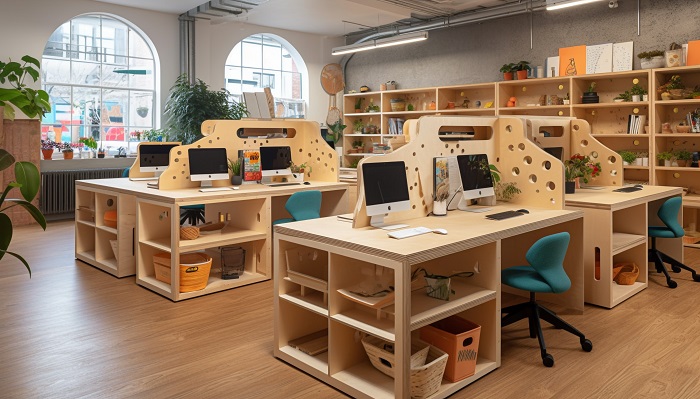Workplace dynamics and employees’ needs have evolved a lot over the years, under the influence of a variety of factors such as tech advances and the transition to remote or hybrid work models. Naturally, office spaces had to keep up with these transformations and adapt in order to accommodate new ways of working and support employee efficiency and productivity.
Indeed, modern-day offices are a far cry from the traditional setups of the past, with standard layouts, rows of cramped cubicles and closed-off offices that emphasized hierarchy, or dull and impersonal designs. However, there’s still plenty of room for improvement as the work environment keeps changing.
With companies becoming more aware of the role that interior design plays in fostering collaboration, improving morale and motivation and ensuring employee wellbeing, we’re now stepping into an era of innovative office design where creativity and functionality go hand in hand.
So, if you want to bring your office space up to date and boost your company’s bottom line, here are the latest design trends and concepts that can help you get one step closer to achieving your goals.
Open plan layouts
Conventional offices featured a clear separation between different work areas which also divided the workforce based on hierarchical principles. Bigger offices were allocated to those occupying higher positions in the company, while average employees worked in closed cubicles.
Today, these physical barriers have started to disappear, being replaced by open-plan layouts. Open spaces encourage collaboration and communication between employees, allowing them to interact and exchange ideas freely without having to go through a maze of walls and confined areas to connect with one another.
The availability of communal spaces and lounge rooms represents a big step forward in modernising work environments. Having these areas fitted with comfortable furnishings designed by forward-thinking companies like Vepa, and integrating tech equipment are also key in enhancing the functionality and appeal of the office.
Biophilic design
Working in an office for 8 or more hours a day doesn’t leave one much time to connect with nature and enjoy the great outdoors. But if you can’t go outside, you can bring nature indoors. That’s the core concept of biophilic design. The integration of natural materials and elements in an office space might sound a bit farfetched, but studies reveal that introducing biophilic design in the workplace can have a positive impact on employee productivity by reducing stress, improving mood and increasing satisfaction levels.
Maximising natural light, ensuring proper ventilation or adding plants are some of the actions that companies can take to strengthen people’s connection to the natural world and reap the benefits it provides. Those who have larger areas at their disposal can take things one step further and create living walls or even indoor gardens.
Versatile furnishings
Office furniture plays a crucial role in ensuring proper functionality and enabling employees to conduct their tasks safely and efficiently. Back in the day, office setups consisted of fixed workstations with typical desks and chairs that didn’t allow for much movement and kept employees in one place for the entire working day.
Now, with the emergence of versatile furniture pieces like moving desks, adjustable chairs, rolling file cabinets, or desk converters, employees enjoy a more dynamic work setting and can customise their workstations according to their needs and preferences.
Sustainability
Modern office spaces are designed with sustainability in mind. This implies creating workplaces that strike a balance between environmental protection and functionality, and have a low carbon footprint. There are various measures that companies can take in this respect. increasing natural light by accommodating larger windows or installing skylights as well as choosing energy-efficient equipment and fixtures, or using renewable energy sources can significantly reduce energy consumption.
Additionally, repurposing or revamping furniture and other interior design elements instead of discarding them and replacing them with new ones can also benefit the planet and the company’s bottom line. Moreover, investing in eco-friendly pieces can help firms reduce their environmental footprint and create stylish and comfortable interiors. If you want to explore options for sustainable furniture, you can check out https://vepa.co.uk/.
Flexibility
Creating different spaces that serve different purposes is extremely important in today’s work culture. Innovative office designs include a combination of communal areas, meeting rooms, private offices, lunge zones, and focus rooms that promote autonomy and flexibility.
This allows employees to move from one place to another throughout the day depending on the tasks they need to perform. It’s also a well-known fact that different people have different working styles, so providing a variety of work areas gives each employee the opportunity to choose the environment that best suits their work style and needs.
Multifunctional spaces
Offices are generally used in multiple ways by multiple people which emphasizes the need for adaptability and multi-functionality. That’s where modular spaces come into play. This design concept focuses on creating settings that can easily adapt and transform in accordance with the current needs of a business.
This is particularly useful for smaller offices that have to make the most of every square inch available but it can be just as easily applied in companies looking to maximise their space and facilitate scalability.
Art and colour
Traditionally, office spaces have embraced a rather minimalistic interior design which in most cases translated into a monotonous and sterile-looking environment. Now we’re moving away from this outdated approach, with most office spaces leveraging colour physiology to create settings that are soothing and welcoming while also being conducive to creativity and productivity. Similarly, integrating art into office design is a great way to enhance visual appeal and encourage creative thinking.
More than building a place for people to work, modern office design aims to unleash the power of creativity and innovation to provide an environment where employees feel comfortable, inspired and engaged, so anyone gets to benefit from it.




